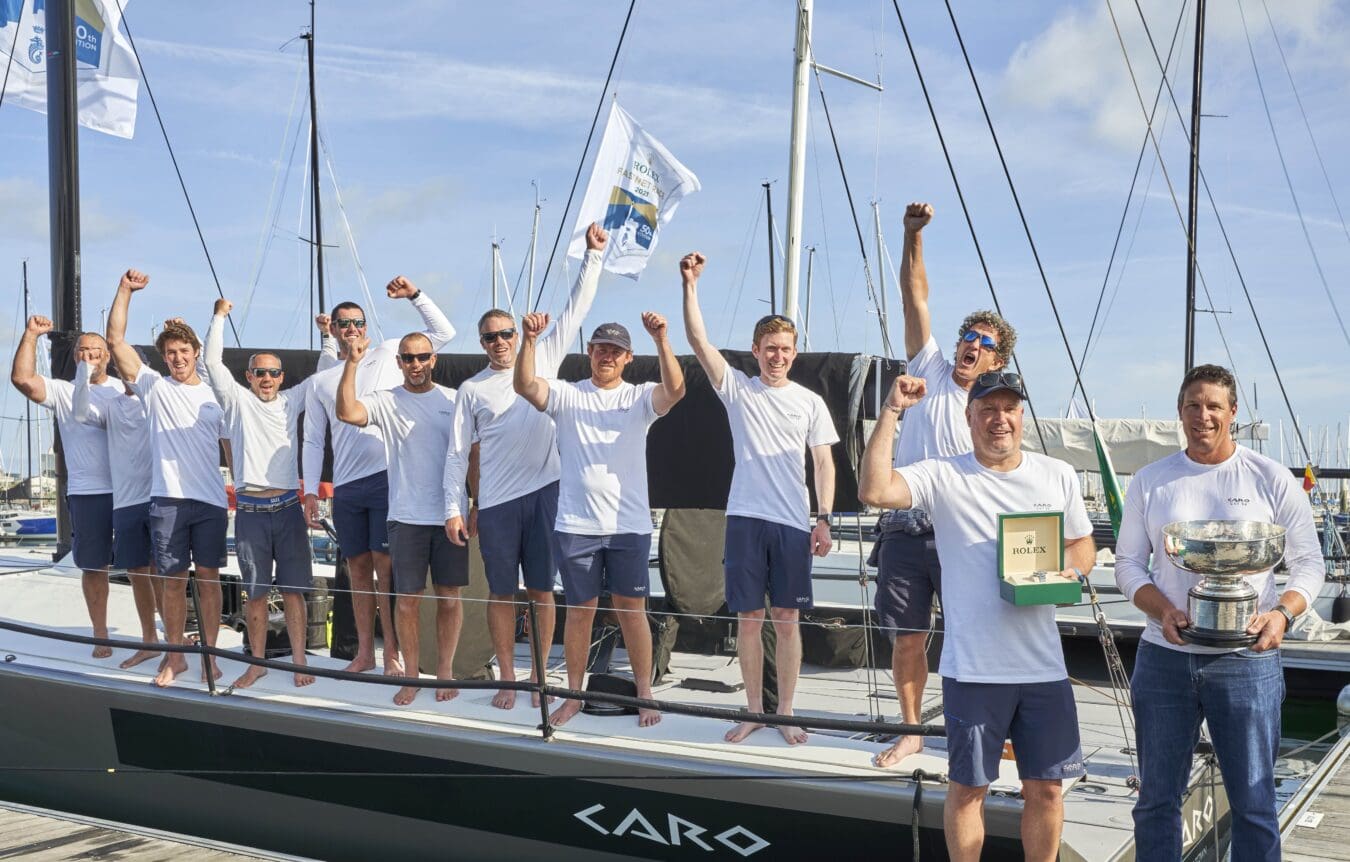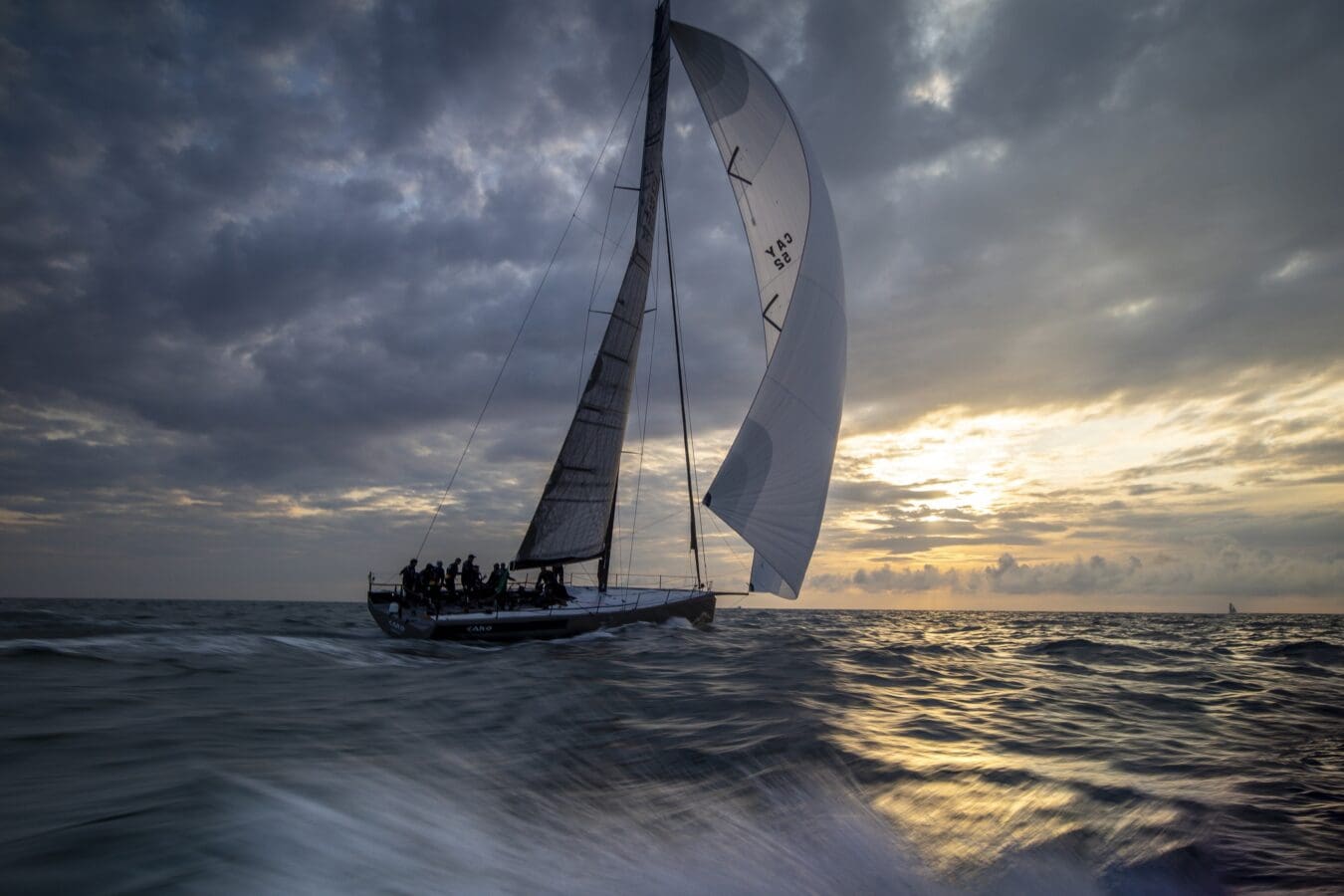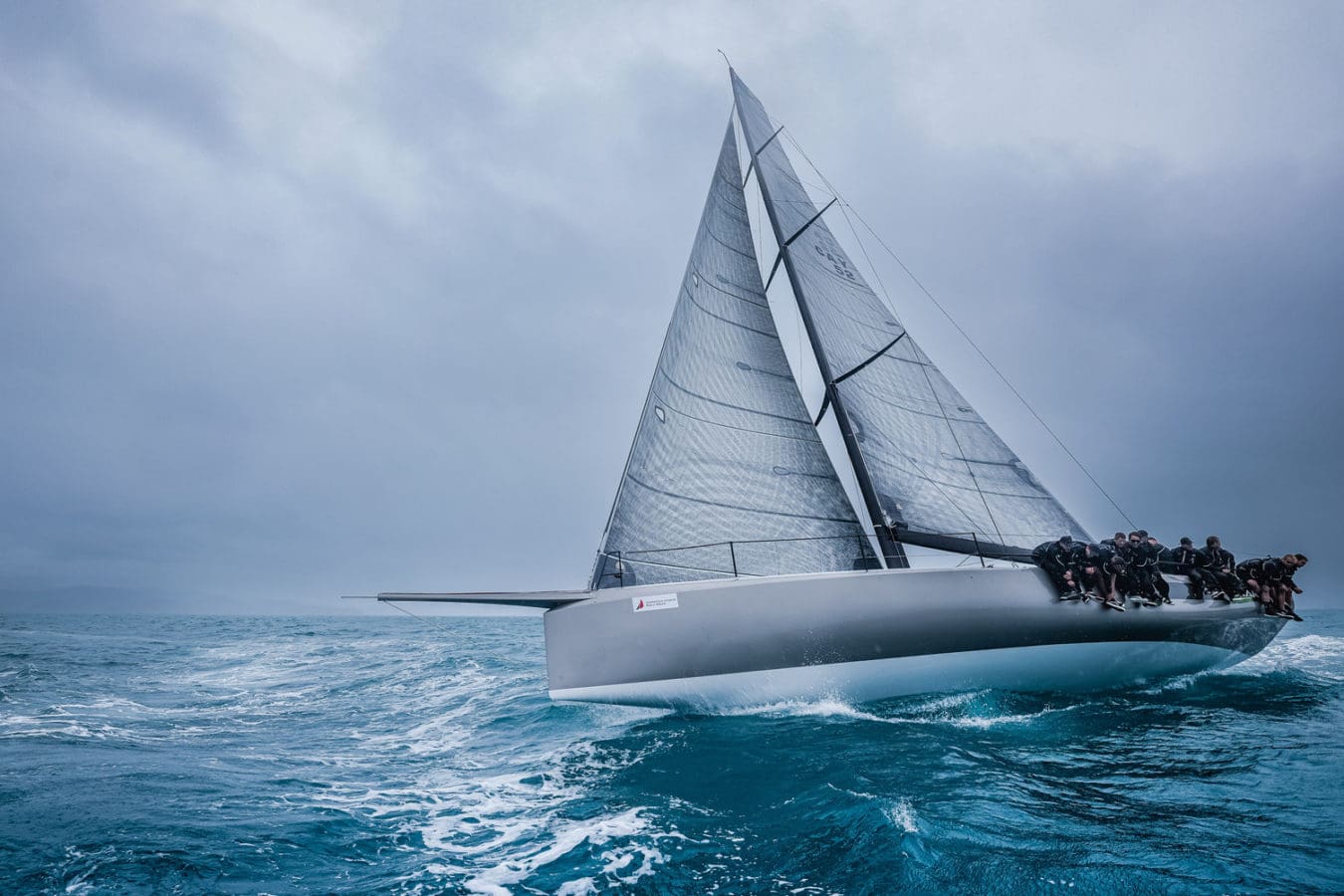Seahorse Magazine // written by Ivor Wilkins. Dec 2023
The value of the Doyle Sails expert goes far beyond the role of sailmaker
Success, according to the prolific 19th century American inventor Thomas Edison, is 10 per cent inspiration and 90 per cent perspiration. It is also a formula Justin Ferris applies to grand prix racing. Weeks and months before a major ocean race, Ferris is sweating the detail – strategising course management, studying weather, optimising sail inventories and performance packages and probing rating systems for advantage down to the nth degree.
As a senior member of the Doyle Sails team it is easy to typecast him as “sailmaker” and leave it at that. However, the New Zealand-based four-time Volvo Ocean Race veteran’s real value within a grand prix team – and within Doyle Sails – has a much wider scope.

Caro, the Botin-designed offshore TP52 that swept to a convincing two-hour victory in this year’s stormy Rolex Fastnet Race, is a case in point. From the moment Swiss owner Max Klink framed his ambition to take on the major ocean classics – the Rolex Fastnet, Middle Sea Race, Sydney-Hobart – Ferris has been at his side.
He project-managed the build of the boat at Core Builders Composites (now SailGP Technologies) in New Zealand, a role that became more intimate as Covid lockdowns excluded any hands-on involvement from the usual run of specialists in such a complex undertaking.
‘I lived through the build on a day-to-day basis. It was Max’s dream, but my baby,’ he jokes.
‘I was given scope to build the best 52ft boat possible. The build of the boat, the concepts, systems and set-up became my responsibility,’ he adds, while fully acknowledging the Botin design office and the input of a wider but remote team.
Caro is not a straightforward yacht. A major feature is its flexibility, with two distinct modes for inshore and offshore racing. In its offshore configuration, it has a larger rudder with wheel steering, water ballast, a galley, head and crew bunks. For inshore racing, a smaller rudder with tiller steering is installed, the head, galley and bunks are removed and the water ballast de-commissioned.
‘In my opinion, it is the best built offshore 52 in the world,’ says Klink. ‘It is like a work of art.’
Out of the blocks, Caro has enjoyed significant success. On debut in last year’s 40-kt Middle Sea the team finished 3rd, scored a class victory in the Voile de St Barths regatta in the Caribbean and then moved to Australia to win its division at Hamilton Island Race Week before securing 3rd place in the Sydney Hobart.
Working to achieve the owner’s goals, Ferris plans, designs and oversees the construction of the Doyle Sails inventory, but also plays a central role in the racing programme, managing the crew, the rating optimisation, the overall performance package.
Rating optimisation alone occupies a big slice of his onshore time. It involves a close study of the next race, what rating systems will apply and running multiple computer simulations on how to set up the boat accordingly. ‘Each handicap system has its own rules and my role is to put together all the parts of the puzzle and optimise the boat for every race and handicap system. It is a big part of how these boats perform.


‘With Caro, for example, we change our rating and re-mode the boat for every race. You have to do it. You can’t expect to just show up and say the rating set-up for the Hobart worked pretty well, so we will keep it the same for the Caribbean 600. It is a completely different race.’
On the water in race mode, Ferris typically serves as watch captain, sail trimmer and helmsman. On top of all the pre-race planning and optimisation, the key to Caro’s Fastnet success also lay in preparation (perspiration) before the race began. With a forecast of heavy weather for the early part of the race, Caro went out in similar conditions three days earlier and completed a series of practice starts plus a lap of the Isle of Wight in full race mode, complete with sail changes, reefs, high-pressure gybes and survival mode tactics such as reducing runner loads, shedding water ballast and taking crew off the rail.
‘In hindsight, that was probably the most valuable thing we did. As a crew, we all got acclimatised to what the conditions were going to be like,’ says Ferris. Despite the practice session and plenty of forewarning – not to mention four races around the planet – nothing quite prepared Ferris for the conditions after the start where an outgoing tide met with opposing winds up to 40kts. ‘There were several times when we stopped racing and moved into survival mode, nursing the boat through the conditions.’
At the notorious headlands along the south coast of England, the wind over tide conditions heaped up severe standing waves. One boat sank and the record entry of 430 yachts dwindled as 166 retired, many with damage. The worst of it was at Portland Bill, near Weymouth. ‘The movement of water there was like watching Olympic kayaking where it looks like the paddlers are getting sucked under heavy rapids before they pop back up again. ’
Once through the worst of the storm, the Caro crew swung back into full-race mode, meticulously planned and executed their dawn rounding of the iconic Fastnet Rock, took two strategic hitches to the south to escape a light patch of breeze and set up a faster angle back to England and launched a barnstorming 20-kt plus run to the finish in France.
‘We really pushed the boat. We were doing things we had never done before – on the ragged edge all the way.’ And, in the process, delivering the owner with one of the most cherished trophies in ocean racing and an experience ‘I will tell my grandchildren about’.
During his periods back in New Zealand between racing, he lives 10 minutes from Doyle Sails’ headquarters and spends time working on his own specific projects, but also in the broader development of products and technology.
At present a buzz of creative energy surrounds Doyle Sails’ new Hybrid material, which is set to take the eternal search for weight saving another step forward. The Caro project was the first full-size race yacht to receive a Hybrid headsail.
‘We have used our Hybrid development sail in training and it is proving very good,’ says Ferris. ‘We aim to change the whole inventory to Hybrid as it becomes available in the near future; it has the potential to be a game-changer.
‘The weight savings would be significant. On a programme like Caro’s, taking up to 50kg of weight off the boat for the same number of sails would be huge.’
This is the working embodiment of the Doyle Sails “By Sailors for Sailors” credo. Spread across its network of lofts, Doyle Sails’ brigade of top-flight grand prix sailors like Ferris are actively racing in all areas of the sport. On the water, they occupy senior positions and apply their experience and expertise to their respective racing campaigns.
Off the water, they bring back new ideas that feed into Doyle Sails’ perpetual quest for refinement and progress. The relationship is symbiotic, benefitting both sides of the equation.
Within the Doyle Sails group, the dynamic is co-operative on technical development and innovation, but competitive on specific design. Proprietary materials like Hybrid and concepts like Structured Luff are shared. But, when it comes to how each designer shapes the technology to create his race team’s inventory, it becomes much more compartmentalised and confidential. With his devotion to detail, Ferris limits himself to five fully-committed race programmes a year, along with design sales support for a number of Doyle Sails lofts around the world.
His close involvement with the Fastnet win, for example, followed a line honours win in the Transpac on Rio100, the much modified Bakewell-White 100-footer. Rio100 is a labour-intensive proposition with all-manual systems to qualify for the Barn Door trophy, which it has won three times. Built in 2003 and extensively modified and lengthened in 2014, Rio100 also features oldschool spinnakers and gennakers.
After the Fastnet, another decisive win in the 530-mile Brisbane to Hamilton Island race on the Reichel Pugh 66ft canting keeler, Alive. In fresh downwind conditions, this was another 20-kt blast all the way, winning on corrected time by six hours. Here again, Ferris’ pre-race homework identified a predominantly broad-reaching course. With Alive’s relatively narrow hull form in mind, Ferris rated the boat with a reaching strut, which came with a rating penalty but proved a good investment on the water.
‘The ability to carry bigger sails for longer and maintain a more efficient flying shape was a real benefit in terms of boatspeed and heeling moment. In 18-20 kts of windspeed with night squalls rising close to 30 kts, we were smoking,’ says Ferris.
Each programme has different personalities and motivations. Some are fully professional, others a mix of pro sailors and amateurs. Callisto, a PAC52 owned by James Murray, is a case in point. Murray and his friends are from the American Midwest and raced competitively on the Great Lakes before graduating from a J109 to offshore campaigning the bigger boat.
Callisto’s 2023 season resume includes winning the 811-mile Miami-Montego Bay Pineapple Cup race, and 2nd in class in the Caribbean 600 (4th overall and first of the 52s). While this range of boat types and skill levels obviously demands a need to accommodate different experience levels, for Ferris the objectives never change: the first is to finish; the second, to finish first.
‘If I ever showed up to race and got told, “let’s not push too hard”, my response would be: “why am I here?” It has been bred into me that when we go racing, we go racing.’ Like the Edison formula, it is another pretty successful recipe for success.
ABOUT DOYLE SAILS // Doyle Sails strives to deliver success through high-performance, high-quality, custom sails that continue to redefine the boundaries of sailmaking technology and innovation; whilst connecting sailors to inspire, support and encourage sailing.
Our obsession with sailing takes us to every corner of the world and onboard every yacht. We become part of teams, share in the adventures of friends and families, sharing our knowledge and experience with those with the same passion. Sailing is in our DNA, and we are the custodians of a legacy that has been supporting sailors for four decades and counting.
